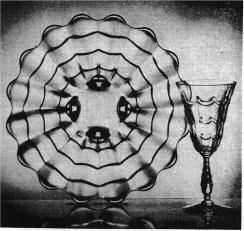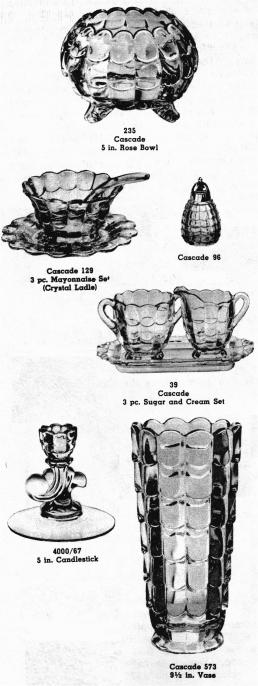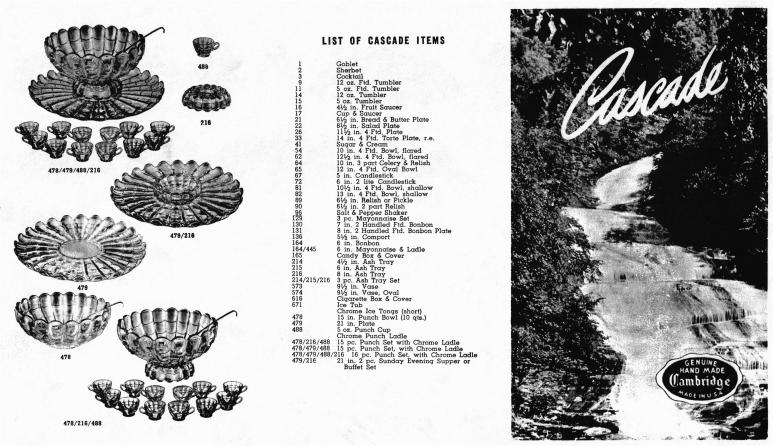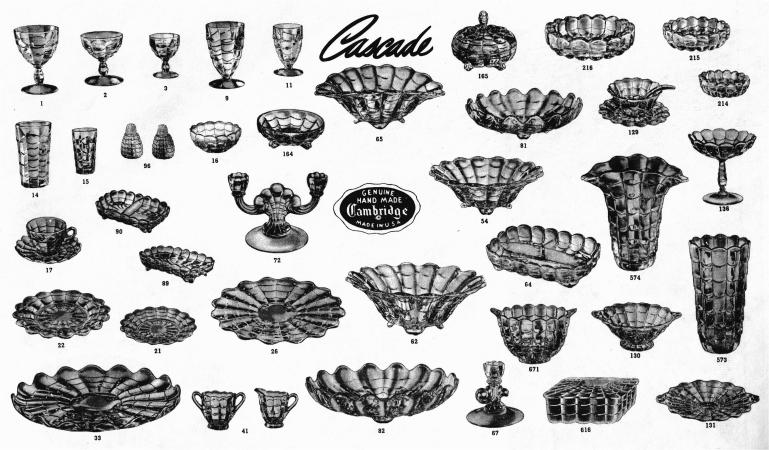Cascade
by Mark A. Nye
Issue No. 152 - December 1985
A post World War II pattern, Cascade or #4000 Line, was actually
designed during the war years as the design patent applications were
filed January 26, 1945 and granted in the spring of the same year.
Probably as the result of wartime shortages in material and labor, and
for other reasons as yet unknown, Cascade was not actually produced for
sale until late 1947 or early 1948.  Among the first trade
advertisements for the pattern was the following taken from the
December 1947 issue of Crockery and Glass Journal,
Among the first trade
advertisements for the pattern was the following taken from the
December 1947 issue of Crockery and Glass Journal,
"Cascade - a fascinating new glassware design by Cambridge to be presented in early January at Cambridge showrooms. The magic enchantment of the clear, tumbling waters of a mountain waterfall are to be seen in Cambridge's distinctive new glassware design - 'Cascade.' This brilliant, beautiful line of fine American crystal - offered at prices surprisingly moderate for such superb quality and styling - may be seen in January at the Cambridge showrooms in Chicago, New York, Denver, Dallas, Los Angeles and Cambridge, Ohio. A cordial invitation is extended to buyers."
From Crockery and Glass as well as other trade journals come the following trade advertisements that originally appeared during 1948.
"Cambridge Glass Co. introduced two new lines of pressed glassware recently. One line, called 'Cascade' includes a complete line of fancy tableware and stemware, including hi-ball and fruit juice tumblers. Stemware retails for about 69 cents each."
"Cascade, a brilliant new glassware, with design featuring a step-down effect in true cascade fashion."
"Here is crystal of magnificent beauty inspired by the gay enchantment of clear, tumbling waters a splash with wondrous brilliance. The step-down effect of the pattern in true cascade fashion is an innovation in fine glassware design.'
"Like a stream of pure light tumbling rhythmically into sun-splashed pools, Cascade brings you one of the most fascinating brilliant new crystal designs to be seen in years. It is a handmade modern crystal in a variety of pieces - substantial, ornamental use. Priced moderately at good stores."
January 1949 saw this description of Cascade appearing in Crockery and Glass Journal.
"Cascade by Cambridge - the rhythmic pattern of falling sunlit waters captured in even more brilliant crystal! Cascade by Cambridge - wholly modern, therefore practical in any setting. Display this popular nationally advertised design now for volume selling."
It was also during 1949 that Cambridge advertisements in Ladies Home Journal were promoting the Cascade line in this manner:
"Cascade by Cambridge - Sturdy, modern, magnificent. Glory in the splendor of this dazzling, rich table crystal, bountiful with brilliance and created for every day use! For Cascade is definitely modern and robust in design - fashioned in shapes you'll find as practical as they are beautiful."
"Cascade by Cambridge - Pamper this fascinating new crystal for its beauty but use it every day! For Cascade is sturdy, modern - meant to be an 'all occasion' design, meant to be practical, and is! How your friends will compliment you on its flawless clarity, its rich brilliance! A superb gift for the bride."
Thus we have the descriptive text Cambridge used to attract buyers for the Cascade line. It is as enticing today as it must have been almost forty years ago.
 The Cascade line is, to today's collectors and for all practical
purposes, a pressed line. Originally, it was to have included at least
a blown goblet and perhaps a full line of blown stemware. A blown
goblet was shown in a trade advertisement (see photo) published in
February 1948 and at least one example is known. However, no catalog or
price list reference has been found for blown Cascade stemware.
The Cascade line is, to today's collectors and for all practical
purposes, a pressed line. Originally, it was to have included at least
a blown goblet and perhaps a full line of blown stemware. A blown
goblet was shown in a trade advertisement (see photo) published in
February 1948 and at least one example is known. However, no catalog or
price list reference has been found for blown Cascade stemware.
The first available listing of the Cascade line is the June 1949 catalog and price list in which 44 items are listed and shown. At that time, there was no listing for Cascade items in color, production being done only in crystal. The Cascade line was not a complete dinnerware line, at least as it was promoted in 1949 and later, as there is no dinner plate. The Cascade place setting consists of a bread and butter plate, 8½" salad plate, cup and saucer, fruit saucer, four tumblers (two are flat and two are footed), goblet, sherbet, and cocktail. Serving and accessory items, ash trays, cigarette box, three vases and a punch set complete the line. (The punch set was discussed as a part of the series dealing with punch bowls - see August 1984 issue of the Cambridge Crystal Ball.)
About the time mandarin gold and emerald (late, dark green) were introduced in the summer of 1949, supplemental pages to the June 1949 Cambridge catalog were issued. Here we find the first mention of colored Cascade. Shown as being available in these two colors were the #129 3-piece mayonnaise set with crystal ladle, the #165 candy box and cover, the Cascade #573 9½" vase, the #41 sugar and cream, and the 3-piece sugar and cream set - Cascade #39. Do note very carefully that there is no Cascade patterned tray for the sugar and cream. The tray used in both crystal and color is the #37 tray from the Corinth line and when found in color belongs to the Cascade line.
The same array of pieces offered in June 1949 remained available in September 1950. The colored Cascade items, except for the 3-piece mayonnaise set, were also a part of the Cambridge line as the 1950s began. For some reason, yet unknown, the mayonnaise set in color had been discontinued in the previous months.
Between June 1949 and September 1950, a price increase went into effect. In September 1950 Cascade stemware was listed at 80 cents each, versus the 70 cents each retail price in 1949. In addition, the Cascade salt and pepper shakers, as well as most shakers, were now being offered with either plastic or chrome tops with chrome commanding a higher price.
By October 1953, only 12 items remained in the Cascade line; the stemware and tumblers; salad plate; the 8" ash tray which, by the way, is also used as the base to the punch bowl; the punch bowl; the 21" underplate to the punch bowl; and the punch cup. None of these items were listed as being available in color.
Among the molds used to produce the milk glass line were at least two from the Cascade line. The #165 candy box and cover which was designated W89 and the Cascade #573 vase, made in milk glass as W133. Both items were illustrated on the supplemental catalog pages. However, the price list issued for the milk glass line stated that several items illustrated were not actually in production. Included in this group was the W89 or milk glass Cascade candy and cover.
Just before the reopening of the Cambridge factory in the early spring of 1955, a physical inventory of the plant was taken. At that time, the Cascade inventory consisted of 1 punch bowl, 3 underplates, 24 dozen punch cups, and 114 dozen additional pieces, consisting primarily of cocktails, 12 oz. ftd. tumblers, and 5 oz. flat tumblers. Also on hand were 2 dozen of the W133 vases, these listed as being discontinued ware.
The 12 items available in October 1953 were made available during the first years of the reopen period but the line was totally dropped sometime between late 1956 and the issuance of the final Cambridge price list, dated 1958.
In addition to the colors already mentioned, a few pieces of Cascade have been found in Crown Tuscan and two unusual goblets are known, one in Tahoe blue and one in Carmen. These latter two items must be considered very unusual and could very well be one of a kind items, highly experimental in nature. While not in the same rarity class as the two colored goblets, Crown Tuscan Cascade will be found in very few Cambridge collections.
The Cascade stemware was molded in one piece, that is the stem and bowl were not produced separately and then joined. This brings us to an unusual feature of the Cascade line, the existence of two styles of stemware, one with the "cascades" on the stem going in the same direction as those on the bowl, namely downward, and a second version with the stem "cascades" pointed upward, toward the bowl, while those on the bowl still go downward. The whys and when of the variant remain unanswered questions.
Cascade, while not abundant, is available in today's market place. It makes a good pattern to collect for frequent use since it is a durable pattern, one not easily broken, and remains relatively inexpensive.


